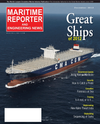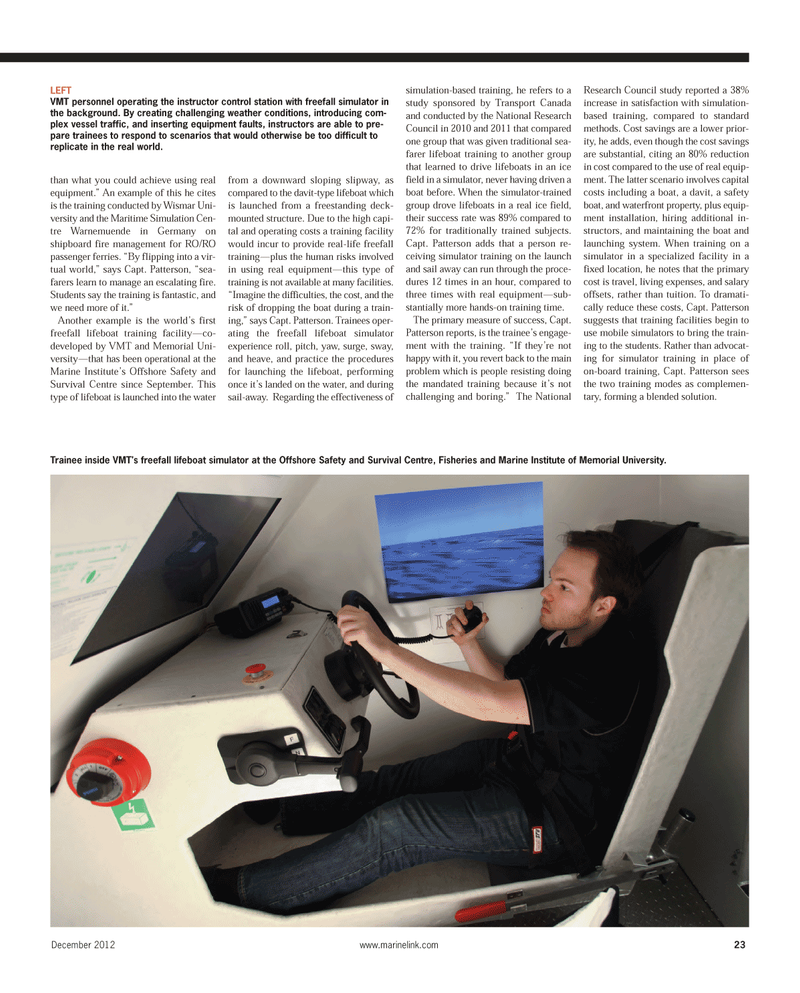
Page 23: of Maritime Reporter Magazine (December 2012)
Great Ships of 2012
Read this page in Pdf, Flash or Html5 edition of December 2012 Maritime Reporter Magazine
December 2012www.marinelink.com 23than what you could achieve using real equipment.? An example of this he cites is the training conducted by Wismar Uni- versity and the Maritime Simulation Cen- tre Warnemuende in Germany on shipboard fire management for RO/RO passenger ferries. ?By flipping into a vir- tual world,? says Capt. Patterson, ?sea- farers learn to manage an escalating fire. Students say the training is fantastic, and we need more of it.? Another example is the world?s first freefall lifeboat training facility?co- developed by VMT and Memorial Uni- versity?that has been operational at the Marine Institute?s Offshore Safety and Survival Centre since September. This type of lifeboat is launched into the water from a downward sloping slipway, as compared to the davit-type lifeboat which is launched from a freestanding deck-mounted structure. Due to the high capi-tal and operating costs a training facility would incur to provide real-life freefall training?plus the human risks involved in using real equipment?this type oftraining is not available at many facilities. ?Imagine the difficulties, the cost, and the risk of dropping the boat during a train-ing,? says Capt. Patterson. Trainees oper- ating the freefall lifeboat simulator experience roll, pitch, yaw, surge, sway, and heave, and practice the procedures for launching the lifeboat, performingonce it?s landed on the water, and during sail-away. Regarding the effectiveness of simulation-based training, he refers to astudy sponsored by Transport Canada and conducted by the National ResearchCouncil in 2010 and 2011 that comparedone group that was given traditional sea- farer lifeboat training to another group that learned to drive lifeboats in an ice field in a simulator, never having driven a boat before. When the simulator-trained group drove lifeboats in a real ice field, their success rate was 89% compared to 72% for traditionally trained subjects.Capt. Patterson adds that a person re- ceiving simulator training on the launch and sail away can run through the proce- dures 12 times in an hour, compared to three times with real equipment?sub-stantially more hands-on training time. The primary measure of success, Capt.Patterson reports, is the trainee?s engage- ment with the training. ?If they?re not happy with it, you revert back to the main problem which is people resisting doingthe mandated training because it?s not challenging and boring.? The National Research Council study reported a 38%increase in satisfaction with simulation- based training, compared to standardmethods. Cost savings are a lower prior- ity, he adds, even though the cost savings are substantial, citing an 80% reductionin cost compared to the use of real equip-ment. The latter scenario involves capital costs including a boat, a davit, a safety boat, and waterfront property, plus equip- ment installation, hiring additional in-structors, and maintaining the boat andlaunching system. When training on a simulator in a specialized facility in a fixed location, he notes that the primary cost is travel, living expenses, and salary offsets, rather than tuition. To dramati- cally reduce these costs, Capt. Patterson suggests that training facilities begin to use mobile simulators to bring the train-ing to the students. Rather than advocat- ing for simulator training in place ofon-board training, Capt. Patterson sees the two training modes as complemen- tary, forming a blended solution. Trainee inside VMT's freefall lifeboat simulator at the Offshore Safety and Survival Centre, Fisheries and Marine Institute of Memorial University. LEFTVMT personnel operating the instructor control station with freefall simulator in the background. By creating challenging weather conditions, introducing com- plex vessel traffic, and inserting equipment faults, instructors are able to pre- pare trainees to respond to scenarios that would otherwise be too difficult to replicate in the real world. MR#12 (18-25):MR Template 12/3/2012 12:02 PM Page 23

 22
22

 24
24
